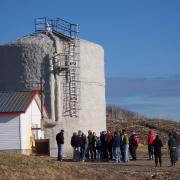When manure is anaerobically digested, the biogas produced is primarily composed of methane and carbon dioxide, with lesser amounts of hydrogen sulfide, ammonia, and other gases. Each of these gases has safety issues. Overall, biogas risks include explosion, asphyxiation, disease, and hydrogen sulfide poisoning.
 |
| Image: US Municipal Supply Company. |
Extreme caution is necessary when working with biogas. Adequate ventilation, appropriate precautions, good work practices, engineering controls, and adequate personal protective equipment will minimize the dangers associated with biogas. Wherever possible, …



 Harnessing energy from livestock waste.
Harnessing energy from livestock waste.